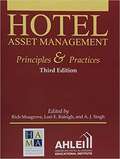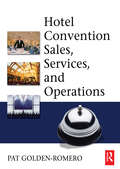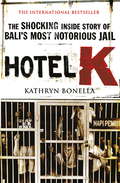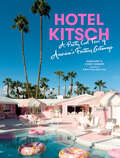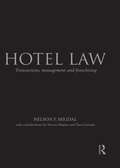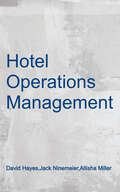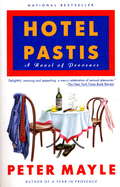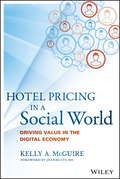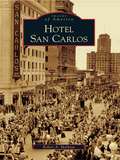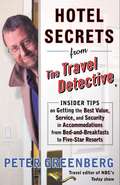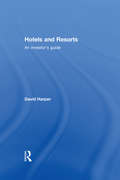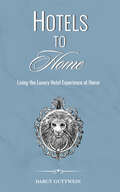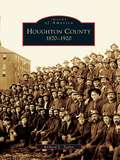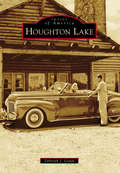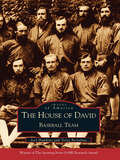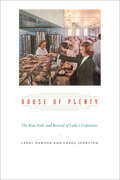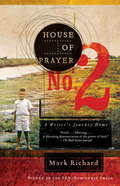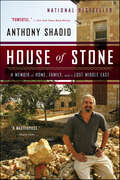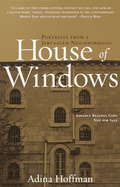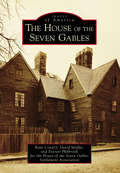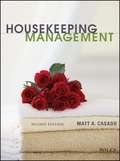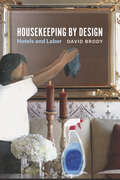- Table View
- List View
Hotel Asset Management: Principles And Practices
by Rich Musgrove Lori Raleigh A. J. SinghThe third edition of this book takes a look at the challenges and opportunities faced by hotel owners, lodging industry real estate professionals, and hotel company executives, with articles written by industry leaders in asset management. This edition is the most comprehensive to date and includes twenty-one chapters by 36 authors, covering topics of keen interest to hotel owners, investors and asset managers.
Hotel Bosphorus
by Ruth Whitehouse Esmahan AykolKatie Hirschel is the proud owner of Istanbul's only mystery bookshop. When the director of a film starring an old school friend is found murdered in his hotel Katie starts her own maverick investigation. After all her friend Petra is the police's principal suspect and reading all those detective novels must have taught Katie something.
Hotel Brasil
by Frei Betto Jethro SoutarAccording to the police, the victim was stabbed in the heart before the head was separated from the body. As the investigation continues other hotel clients are decapitated, usually with the head found delicately balanced on the knees of the sitting victim. A witty, touching account of life at the edge of Brazilian society, dressed up as a murder mystery.
Hotel Convention Sales, Services and Operations
by Pat Golden-RomeroThis text provides a comprehensive look at the fast growing meetings and convention market segment. A useful “how- to” guide, it takes students through all aspects of selling and servicing a convention at a hotel or other group meeting facility. In addition, it profiles the customer for meetings and conventions, the planners in charge of site selection, and facilities they commonly use. Also includes “Industry Insiders” planning tips and case studies direct from professionals in Convention Services departments.
Hotel K: The Shocking Inside Story of Bali's Most Notorious Jail
by Kathryn BonellaHotel K - Bali's most notorious jail - is Hell in Paradise.Welcome to Hotel Kerobokan, or Hotel K, Bali's most notorious jail. Its walls touch paradise; sparkling oceans, surf beaches and palm trees on one side, while on the other it's a dark, bizarre and truly frightening underworld of sex, drugs, violence and squalor. Hotel K's filthy and disease ridden cells have been home to the infamous and the tragic: a Balinese King, Gordon Ramsay's brother, Muslim terror bombers, beautiful women tourists and surfers from across the globe. Petty thieves share cells with killers, rapists, and gangsters. Hardened drug traffickers sleep alongside unlucky tourists, who've seen their holiday turn from paradise to hell over one ecstasy pill. Hotel K is the shocking inside story of the jail and its inmates, revealing the wild 'sex nights' organised by corrupt guards for the prisoners who have cash to pay, the jail's ecstasy factory, the killings made to look like suicides, the days out at the beach, the escapes and the corruption that means anything is for sale - including a fully catered Italian jail wedding, or a luxury cell upgrade with a Bose sound system. The truth about the dark heart of Bali explodes off the page.
Hotel Kitsch: A Pretty Cool Tour of America's Fantasy Getaways
by Margaret Bienert Corey BienertA visual celebration of the best fantasy suites and honeymoon hotels across America and beyond, from the creators of A Pretty Cool Hotel Tour In 1963, the savvy owners of the Cove Haven Resort in the Poconos unveiled their heart-shaped tub. Like Elvis Presley and Playboy magazine, it launched a postwar phenomenon that defined a new era of pop pleasure: the honeymoon hotel. Destinations across the country were soon racing to catch up, installing not just heart-shaped tubs but all types of over-the-top design flourishes, from pink shag carpeting to immersive worlds worthy of a Broadway stage set, in order to create a sense of romance, fantasy, even adventure. From the photographers and inveterate travelers behind the social media sensation A Pretty Cool Hotel Tour, Hotel Kitsch celebrates dozens of creative, nostalgic, one-of-a-kind hotels that span the heart of the Poconos and across the United States to Mexico, Spain, and the UK. Discover, in the middle of Iowa, a jungle room with fake trees and foliage surrounding the bed as if it had taken its cue from Where the Wild Things Are. Or Jules&’ Undersea Lodge in Key Largo where the rooms are reached by scuba diving. An Arctic Cave room at a hotel in Kentucky with its carved blue walls and not a window to be found. And on the California coast, the iconic Madonna Inn featuring 110 rooms, each themed and no two alike. Along the way, authors Margaret and Corey Bienert uncover too many wild details to mention, including unconventional beds (a Cadillac, a clamshell, a sandwich), mirrors on mirrors on mirrors, in-room swimming pools, full suits of armor, and fiber-optic star ceilings. While it&’s not a travel guide, every destination in Hotel Kitsch is open for business. Time to check in.
Hotel Law: Transactions, Management and Franchising
by Nelson MigdalHotel Law, Transactions, Management and Franchising presents a practical guide to the issues that face lawyers and industry leaders working in the hospitality field. It aims to develop the reader’s understanding of the acquisition process and the complex relationships in management and franchise deals that dominate the hotel industry. This text is written primarily as a desktop reference for legal practitioners working in the hotel law field and is also suitable for students studying towards hotel and hospitality careers both at an undergraduate and law school or graduate level. The highly experienced author, contributors and editors offer insights into the industry players and their preferred positions, desired outcomes, and the potential pitfalls that can ensnare even the most well-planned deals. With broad coverage of the rapidly growing field of hospitality law—including gaming, recreation, and amenities— the book’s approach examines the dominant models of hotel ownership, management and franchising, and includes independent hotels and the move towards complex resorts. The book’s coverage of key legal topics ranges from real estate, to intellectual property, contracts, and finance.Hotel Law will give readers an understanding of the hospitality industry from the perspective of the transactional practitioner, while examining the multi-party relationships and agreements that develop between an owner, operator, licensor and lender.
Hotel Operations Management
by David Hayes Allisha Miller Jack NinemeierHotel Operations Management provides an up-to-date and comprehensive examination of all aspects of hotel administration from the viewpoint of the hotel general manager. Detailed information addresses the operating departments of a full-service hotel: Human Resources; Controller; The Front Office; Housekeeping; Food and Beverage; Safety and Property Security; Sales and Marketing; Accounting; and Facility Engineering and Maintenance. In-depth discussions highlight the importance of human resources in the labor-intensive hotel industry, franchising and contract management of properties in an ever-decreasing “Mom and Pop” segment, and hotel management in a global environment. Updated throughout to ensure that readers have the latest information, the Third Edition also includes new case studies, an entirely new chapter on guest services, and new end-of-chapter questions. This accurate book will give prospective hotel managers insight into all of the procedures effective managers use to ensure their hotel¿’s―and their own―success.
Hotel Pastis: A Novel Of Provence (Points Ser. #506)
by Peter MayleHaving delighted millions of Americans with A Year in Provence and Toujours Provence, Peter Mayle treats us to a wonderfully entertaining novel of escape, romance and adventure. played in the landscape he has made so irresistible.Simon Shaw, a forty-two-year-old advertising tycoon, worn down by insatiable clients and a rapacious ex-wife, wants to get away from it all. On impulse he drives to the south of France. When an accident leaves him stranded in a small village in the Luberon, an enchanting Frenchwoman, who is between husbands, comes to his rescue and soon lures him into buying the local gendarmerie. Together they transform it into a little jewel of a hotel. And life seems idyllic. But at the same time, a crook, recently released from the Marseilles prison, is plotting to rob the bank in the nearby town. Paths cross. schemes go awry -- and through it all Peter Mayle delights us with the intrigues of the haut monde that descends on the Hotel Pastis and the machinations of the bad guys, as everything conspires to threaten the heaven on earth that Simon Shaw has envisioned.
Hotel Portofino: A MAJOR ITV DRAMA
by J. P O’ConnellRomance, intrigue, and dangerous ambitions combine to create the perfect escape: welcome to the beautiful Hotel Portofino on the magical Italian Riviera. ***NOW A MAJOR TV DRAMA*** It is the summer of 1927 and Hotel Portofino is prospering under Bella&’s stewardship. As the season begins, Bella is keenly looking forward to her son Lucian&’s imminent arrival and the chance to discuss with him her plans to convert the hotel&’s basement into a spa. But then Bella&’s husband Cecil turns up unannounced, Over the course of several hot weeks in the middle of the Italian summer, Bella is forced to confront the reality of her relationship with Cecil and to decide to what extent she is prepared to go against social convention to get what she wants. As she welcomes her guests, old and new, an anonymous visit from a travel guide inspector threatens to make or break the hotel&’s future.Enjoy a new season at Hotel Portofino, a heady historical drama set during the 1920s. Perfect for fans of Downton Abbey and The Durrells.
Hotel Pricing in a Social World: Driving Value In The Digital Economy (Wiley And Sas Business Ser.)
by Jeannette Ho Kelly A. McguireTake control of revenue management in the new hotel economy Hotel Pricing in a Social World: How to Drive Value in the New Hotel Economy is an insightful resource that provides guidance on improving organizational decision making to keep your hotel relevant, from a pricing standpoint, in the often chaotic hotel landscape. This groundbreaking book clearly showcases the current environment of the hotel industry, and describes new and emerging trends that can impact your revenue management tactics. This essential text prepares you to survive and thrive in today's highly competitive market, and outlines the best approach to building profitable pricing strategies that follow both tactical and strategic best practices. Revenue management has become a key activity in the highly social environment of today's hotel industry, thanks to mobile technology and social media. Though relatively new, revenue management is a quickly-evolving discipline that requires precision if you want to maintain your hotel's relevance in the market. Leverage original research, case studies, and industry examples to understand the practical application of key concepts Explore current market conditions that have an impact on revenue management Consider how advances in data management, analytics, and data visualization can impact revenue management practices Identify how revenue management can help you take advantage of market opportunities and overcome challenges Hotel Pricing in a Social World: How to Drive Value in the New Hotel Economy is an essential text for hotel CFOs, CMOs, revenue managers, and operations managers who want to leverage revenue management techniques to keep their hotel competitive.
Hotel San Carlos
by Robert A. MelikianOn the corner of Central Avenue and Monroe Street, in the center of downtown Phoenix, is the historic Hotel San Carlos. Local Native Americans once worshipped a god of learning in this same area, and so early white settlers chose the site for the city's first school, the Little Adobe School, in 1873. After the Little Adobe School, the location served as a ballpark, a brick schoolhouse, the Central School, and finally the Hotel San Carlos, which opened in March 1928. The first hotel in Phoenix to boast steam heat, elevators, and air-conditioning, Hotel San Carlos has a remarkable story and has even seen its share of movie stars, including Mae West, Gene Autry, and Marilyn Monroe. Clark Gable always stayed in the same corner room on the fourth floor so he could people-watch. Even the friendly ghost of Leone Jensen, who appears regularly at the foot of the guest beds, has added to the unique legacy and continuing popularity of Hotel San Carlos.
Hotel Secrets from the Travel Detective: Insider Tips on Getting the Best Value, Service, and Security in Accomodations from Bed-and-Breakfasts to Five-Star Resorts
by Peter GreenbergIndispensable information for away-from-home lodging, from the author of the New York Times bestseller The Travel DetectiveIn Hotel Secrets from the Travel Detective, America’s best-known and most trusted travel authority reveals the insider knowledge that can make every hotel stay as comfortable as (and sometimes even more cost-efficient than) home. With his incomparable access and nose for news, Peter Greenberg shares the secrets that people who know hotels—managers, maids, reservation clerks, bellhops, chefs, and maintenance guys—don’t want you to know about value, service, safety, security, and cleanliness. Tips include:• How to tell if your room is really clean • What never to order from room service • The real way to prevent hotel crime• How to beat excessive hotel phone charges• The exact rooms where headline-making events took place Drawn from the author’s experiences as both an investigative reporter and a constant traveler, Hotel Secrets from the Travel Detective is an essential guide to everything from luxury resorts to motels, from airport hotels and bed-and-breakfasts to outrageous (and often secret) alternatives to hotels.
Hotels and Resorts: An investor's guide
by David HarperHotels and Resorts: An investor's guide presents a comprehensive analysis of how hotels, golf courses, spas serviced apartments, gyms and health clubs and resorts are developed, operate and are valued. Drawing on over 18 years’ experience in the leisure property industry, David Harper provides invaluable advice on how to buy, develop and sell such properties. Working through the required due diligence process for purchases, including how to identify a "good buy", through the "route map" for a successful development and ending with how to ensure you maximise your returns when selling the asset, this book covers the whole life-cycle of leisure property ownership. Examples of valuations, development issues and sales processes are taken from the USA, UK, France, Nigeria, Kenya, Australia, Hong Kong, Singapore and Brazil provide in depth analysis on the similarities and differences in approach to hotels and resorts in various parts of the world. This book provides invaluable guidance to international investors, developers, asset managers and students in related subject areas.
Hotels to Home: Living the Luxury Hotel Experience at Home
by Darcy GuttweinWhat if you could live the luxury hotel experience at home, every day? Hotels to Home answers that question by creating a new lifestyle template that bridges the gap between your fondest hotel memories and everyday living. Imagine stepping into your entryway with the eager anticipation as when entering your favorite hotel lobby, defining your family’s hotel brand as a lifestyle strategy, finely orchestrating room service for your household, or celebrating the end of each day with personalized turndown service. Taking what might have once been considered ordinary homelife and making your address a highly coveted destination. Less memoir, more guidebook. Peek into the author’s travel essays and enjoy prompts to excavate your own vacation preferences that reveal a holiday lifestyle at home. Welcome to the Hotels to Home lifestyle!
Houghton County: 1870-1920
by Richard E. Taylor"Go West, young man . . ." When Horace Greeley made his famous statement in the pages of Harper's Weekly, he was not referring to the goldfields of the late-1840s California, he was speaking of Michigan's western Upper Peninsula. In the mid- to late 1840s, Michigan's copper resources were rediscovered by state geologist Douglass Houghton, setting off a mining boom rivaled only by the gold rush of 1849. The richest copper and silver ores, and even some gold, were found in the mines of Houghton County. Famous mines such as "Old Reliable," the Quincy mine, and the Calumet and Hecla mines gave up billions of tons of pure native copper and millions of dollars to eastern investors for over 100 years. Railroads, steamship lines, and eventually trolley lines served Houghton County, offering connection to the outside world. Between 1850 and 1920, mining companies attracted immigrants from Cornwall, England; Germany; Italy; Finland; Ireland; the Austro-Hungarian empire; and French Canada. The area was a true melting pot. Although this era of prosperity saw the rise of labor unions, the period culminated in the tragic and unsuccessful strike of 1913.
Houghton Lake
by Deborah I. GouinNestled among northern Michigan's pine trees in Roscommon County is the state's largest inland lake, Houghton Lake. Lumbermen made use of its 20,044 acres to move timber. They banked logs on the lake, the headwaters of the Muskegon River, during the winter cutting season and drove them downriver in the spring to southwestern lumber yards. As Houghton Lake's reputation for good fishing grew, visitors came to try their luck. By the mid-20th century, Houghton Lake became one of the most popular destinations in Michigan. Now, the area is known for its bars, resorts, and winter festival Tip-Up Town USA. Water sports, summer cottages, and nightlife still attract thousands of visitors from Lower Michigan and surrounding states today.
House of David, The: Baseball Team (Images of America)
by Joel Hawkins Terry BertolinoThe Israelite House of David was founded in 1903, as a religious colony in Benton Harbor, Michigan. An entrepreneurial group of worshippers, the colony contributed much to the community, including a traveling baseball team that toured the United States, Canada, and Mexico. The almost 200 images collected here by authors Joel Hawkins and Terry Bertolino document the history of this bearded, barnstorming group of baseball players throughout their careers. The colony accomplished much within the community, credited with inventing the automatic pinsetter used in bowling and the first cold storage facility in the county. However, it was the House of David baseball players that caught the nation's attention, with their long hair and beards, which was forbidden to be cut or shaved as a code of their faith. As news of their prowess spread, the team received more and more press throughout the country. Much like the Negro Leagues of the same period, the House of David baseball players would criss-cross the country, playing with such greats as the Kansas City Monarchs, Pittsburg Crawfords, and Satchel Paige and his All Stars.
House of Plenty: The Rise, Fall, and Revival of Luby's Cafeterias
by Carol Dawson Carol JohnstonScarred by the deaths of his mother and sisters and the failure of his father's business, a young man dreamed of making enough money to retire early and retreat into the secure world that his childhood tragedies had torn from him. But Harry Luby refused to be a robber baron. <P><P>Turning totally against the tide of avaricious capitalism, he determined to make a fortune by doing good. Starting with that unlikely, even naive, ambition in 1911, Harry Luby founded a cafeteria empire that by the 1980s had revenues second only to McDonald's. So successfully did Luby and his heirs satisfy the tastes of America that Luby's became the country's largest cafeteria chain, creating more millionaires per capita among its employees than any other corporation of its size. Even more surprising, the company stayed true to Harry Luby's vision for eight decades, making money by treating its customers and employees exceptionally well.
House of Prayer No. 2: A Writer's Journey Home
by Mark RichardIn this otherworldly memoir of extraordinary power, Mark Richard, an award-winning author, tells his story of growing up in the American South with a heady Gothic mix of racial tension and religious fervor. Called a #x1C;special child,#x1D; Southern social code for mentally-and physically-challenged children, Richard was crippled by deformed hips and was told he would spend his adult life in a wheelchair. During his early years in charity hospitals, Richard observed the drama of other broken boys#x19; lives, children from impoverished Appalachia, tobacco country lowlands, and Richmond#x19;s poorest neighborhoods. The son of a solitary alcoholic father whose hair-trigger temper terrorized his family, and of a mother who sought inner peace through fasting, prayer, and scripture, Richard spent his bedridden childhood withdrawn into the company of books. As a young man, Richard, defying both his doctors and parents, set out to experience as much of the world as he could-as a disc jockey, fishing trawler deckhand, house painter, naval correspondent, aerial photographer, private investigator, foreign journalist, bartender and unsuccessful seminarian-before his hips failed him. While digging irrigation ditches in east Texas, he discovered that a teacher had sent a story of his to theAtlantic, where it was named a winner in the magazine#x19;s national fiction contest launching a career much in the mold of Jack London and Mark Twain. A superbly written and irresistible blend of history, travelogue, and personal reflection,House of Prayer No. 2is a remarkable portrait of a writer#x19;s struggle with his faith, the evolution of his art, and of recognizing one#x19;s singularity in the face of painful disability. Written with humor and a poetic force, this memoir is destined to become a modern classic.
House of Stone: A Memoir of Home, Family, and a Lost Middle East
by Anthony Shadid“Wonderful . . . One of the finest memoirs I’ve read.” — Philip Caputo, Washington PostIn the summer of 2006, racing through Lebanon to report on the Israeli invasion, Anthony Shadid found himself in his family’s ancestral hometown of Marjayoun. There, he discovered his great-grandfather’s once magnificent estate in near ruins, devastated by war. One year later, Shadid returned to Marjayoun, not to chronicle the violence, but to rebuild in its wake.So begins the story of a battle-scarred home and a journalist’s wounded spirit, and of how reconstructing the one came to fortify the other. In this bittersweet and resonant memoir, Shadid creates a mosaic of past and present, tracing the house’s renewal alongside the history of his family’s flight from Lebanon and resettlement in America around the turn of the twentieth century. In the process, he memorializes a lost world and provides profound insights into a shifting Middle East. This paperback edition includes an afterword by the journalist Nada Bakri, Anthony Shadid’s wife, reflecting on his legacy.“A poignant dedication to family, to home, and to history . . . Breathtaking.” — San Francisco Chronicle“Entertaining, informative, and deeply moving . . . House of Stone will stand a long time, for those fortunate enough to read it.” — Telegraph (London)
House of Windows
by Adina HoffmanA brilliant and moving evocation of the rhythms of life (and the darker shadows below it) in a working-class quarter of the world's most fascinating and divided city. In the tradition of the literature of place perfected by such expatriate writers as M. F. K. Fisher and Isak Dinesen, Adina Hoffman's House of Windows compellingly evokes Jerusalem through the prism of the neighborhood where she has lived for eight years since moving from the United States. In a series of interlocking sketches and intimate portraits of the inhabitants of Musrara, a neighborhood on the border of the western (Jewish) and eastern (Arab) sides of the city-a Sephardic grocer, an aging civil servant, a Palestinian gardener, a nosy mother of ten-Hoffman constructs an intimate view of Jerusalem life that will be a revelation to American readers bombarded with politics and headlines. By focusing on the day-to-day pace of existence in this close-knit community, she provides a rich, precise, and refreshingly honest portrait of a city often reduced to cliche-and takes in the larger question of identity and exile that haunts Jews and Palestinians alike.
House of the Seven Gables, The (Images of America)
by David Moffat Everett Philbrook House of the Seven Gables Settlement Association Ryan ConaryThe House of the Seven Gables is an American icon. It is one of the nation�s oldest homes and one of its first historic house museums. Built in 1668, it is a unique and well-restored first period house displaying many preserved 17th- and 18th-century architectural features. Three generations of the seafaring Turner family lived in the home before the American Revolution. In the 19th century, the author Nathaniel Hawthorne was hosted in the house by his cousin, and the setting encouraged his literary genius. After this famous association, the house attracted tourists even before it opened to the public when the artistic Upton family called the mansion home. In 1910, Caroline Emmerton, an enterprising philanthropist, opened the home to raise money to help local immigrants. She restored the structure and brought other historic houses from Salem to the property.
Housekeeping Management
by Matt A. CasadoThe second edition of Housekeeping Management is written from a management perspective of the executive housekeeper in the lodging industry. The overarching concept of the text spotlights three major areas of expertise required for the success of lodging professionals: management of resources, administration of assets, and knowledge of technical operations. The text explores the role of the housekeeping department in hotel/lodging operations, and focuses mainly on the effective communication between the housekeeping, front office, and engineering and maintenance staff. This edition will have the same focus on the management- and administration-based philosophy from the 1st Edition, but with a stronger focus on the engineering aspects of housekeeping. The book will also incorporate new concepts of energy conservation and risk management to address the latest sustainability and security trends in the industry, as well as updated information on guestroom technology.
Housekeeping by Design: Hotels and Labor
by David BrodyOne of the great pleasures of staying in a hotel is spending time in a spotless, neat, and organized space that you don’t have to clean. That doesn’t, however, mean the work disappears—when we’re not looking, someone else is doing it. With Housekeeping by Design, David Brody introduces us to those people—the housekeepers whose labor keeps the rooms clean and the guests happy. Through unprecedented access to staff at several hotels, Brody shows us just how much work goes on behind the scenes—and how much management goes out of its way to make sure that labor stays hidden. We see the incredible amount of hard physical work that is involved in cleaning and preparing a room, how spaces, furniture, and other objects are designed to facilitate a smooth flow of hidden labor, and, crucially, how that design could be improved for workers and management alike if front-line staff were involved in the design process. After reading this fascinating exposé of the ways hotels work—or don’t for housekeepers—one thing is certain: checking in will never be the same again.
